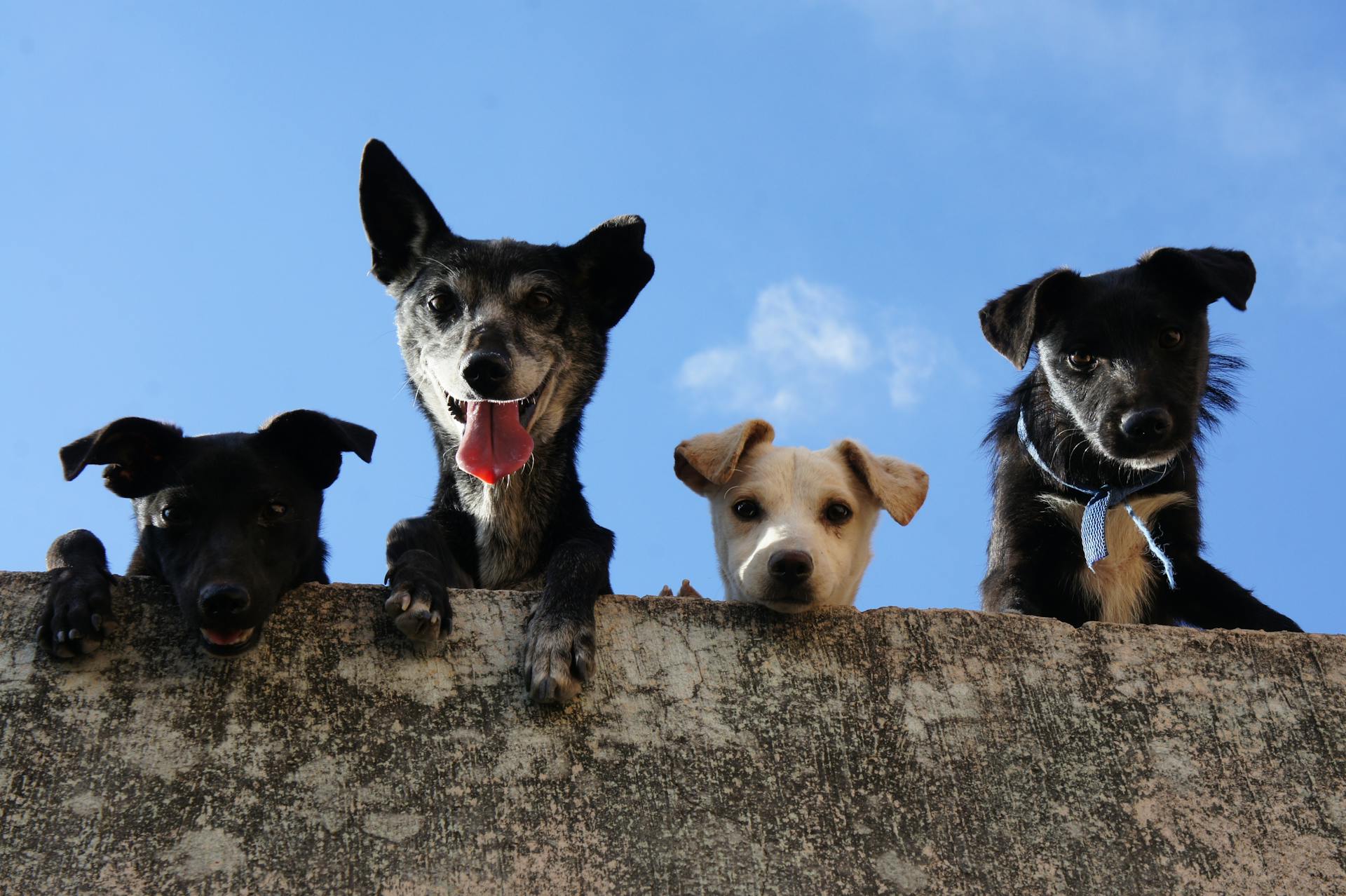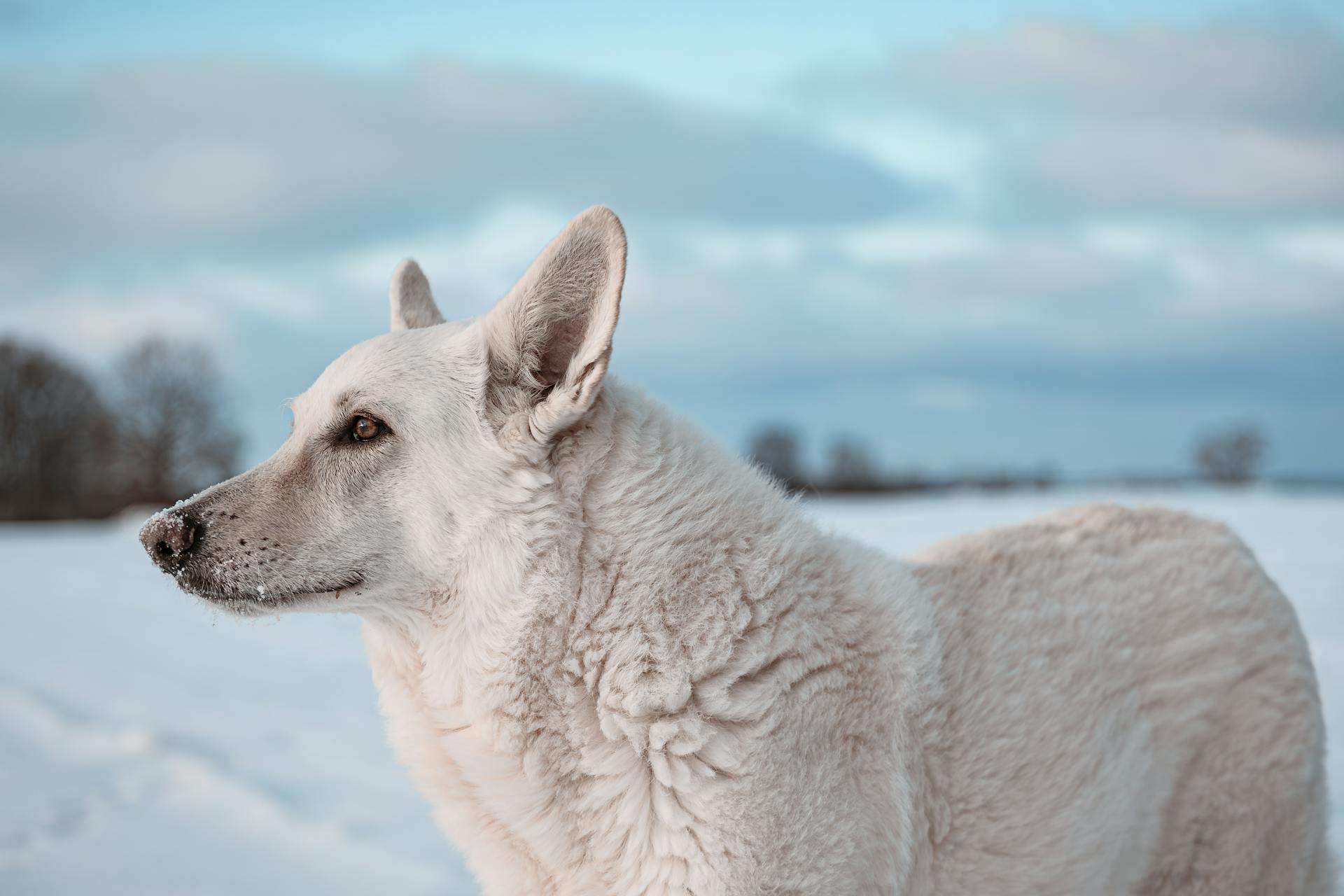
Pica in canines is a fascinating topic, and understanding the reasons behind it can help you address the problem of dogs eating paper.
Dogs are naturally curious creatures, and they often engage in behaviors that seem strange to us, like eating non-food items.
Some common causes of pica in dogs include nutritional deficiencies, boredom, and anxiety.
A lack of mental and physical stimulation can lead to destructive behaviors like eating paper.
In some cases, dogs may eat paper due to a medical condition that affects their digestive system.
According to research, certain breeds are more prone to pica, including Labradors and German Shepherds.
Dogs that eat paper may swallow large amounts of the material, which can cause intestinal blockages or other health issues.
What Is Pica in Dogs?
Pica is an eating disorder that's a bit of a mystery, but we can break it down. It's characterized by the urge to eat objects that aren't food.
Some dogs with pica will eat just one type of item, while others will gobble up a variety of things, like dirt, rocks, books, and even wet wipes.
The items they eat often carry their owner's scent, which can be anything from underwear to pantyhose.
Dogs with pica tend to favor items with their owner's scent, such as underwear, socks, towels, and pantyhose.
Pica can be a sign of an underlying medical issue, like endocrine diseases, nutritional imbalances, or parasitic infections.
Here are some common medical conditions that can trigger pica in canines:
- Endocrine diseases (like diabetes and thyroid disease)
- Nutritional imbalances
- Parasitic infections (such as tapeworms and hookworms)
- Diseases of maldigestion and malabsorption
Pica can also be a sign of behavioral issues, like boredom, anxiety, or stress.
Causes and Symptoms
Dogs eating paper is a common issue that can be caused by several factors. Pica, a disorder characterized by eating non-food objects, can be triggered by medical conditions, nutritional imbalances, and behavioral issues.
Some common medical conditions that can lead to pica in dogs include iron deficiency anemia, inflammatory bowel disease, and hyperthyroidism. These conditions can cause increased appetite, leading to the ingestion of non-food items like paper.
Suggestion: How to Stop Dog from Eating Other Dogs Food
Pica can also be caused by parasitic infections, such as hookworms, and certain medications like corticosteroids and anti-seizure drugs. If your dog is eating paper, it's essential to rule out any underlying medical conditions through a physical exam and diagnostic tests like a complete blood count (CBC) and urinalysis.
Some common symptoms of pica in dogs include vomiting, diarrhea, loose stool, and chronic bad breath. In severe cases, pica can lead to blockages in the intestines, internal ulcerations, and infections. If you suspect your dog has ingested paper, monitor their behavior and watch for signs of gastrointestinal irritation, such as diarrhea, vomiting, and lethargy.
Here are some potential causes of pica in dogs:
- Endocrine diseases (like diabetes and thyroid disease)
- Nutritional imbalances
- Parasitic infections (such as hookworms and tapeworms)
- Diseases of maldigestion and malabsorption
- Medications (such as anti-seizure drugs and steroids)
Causes
Pica in dogs can be caused by a variety of medical conditions, including immune mediated hemolytic anemia, iron deficiency anemia, inflammatory bowel disease, and hookworms intestinal parasites. These conditions can trigger an increased appetite in dogs.
In some cases, pet prescribed medications can also lead to pica. Corticosteroids, such as prednisone, and anti-seizure medications, like phenobarbital, can increase a dog's appetite and lead to pica.

Medical tests, such as a complete blood count (CBC), urinalysis, and a serum biochemistry profile, can help identify underlying diseases that may be causing pica. Your veterinarian may also recommend x-rays to check for any blockages in the digestive tract.
Some common medical conditions that trigger pica in dogs include endocrine diseases, nutritional imbalances, and parasitic infections. These conditions can lead to an increased appetite and a desire to eat non-food items.
Here are some specific medical conditions that can cause pica in dogs:
- Iron deficiency anemia
- Immune mediated hemolytic anemia (IMHA)
- Inflammatory bowel disease (IBD)
- Hookworms intestinal parasites
- Stomach tumor
- Hyperthyroidism
- Diabetes mellitus
- Malnutrition
- Unbalanced diet
- Corticosteroids (such as prednisone)
- Anti-seizure (such as phenobarbital)
Symptoms
Symptoms of pica in dogs can be quite distressing for both you and your pet. Vomiting is one of the most common symptoms, and it can be a sign that your dog has ingested something it shouldn't have.
Diarrhea is another symptom you might notice, and it can be accompanied by loose stool. Your dog's chronic bad breath can also be a sign of pica.
In addition to these symptoms, your dog might experience gastrointestinal irritation, which can lead to a range of issues. Diarrhea, vomiting, chronic bad breath, lethargy, and lack of appetite are all possible symptoms.
You might enjoy: Dog Bad Behaviour

If the ingested object is causing a blockage in the intestines, your dog might experience intractable vomiting, straining or inability to defecate, dark or tarry stools, excessive drooling, abdominal pain, and burping.
Here are some possible symptoms of pica in dogs:
- Vomiting
- Diarrhea
- Loose Stool
- Chronic bad breath
- Lethargy
- Lack of appetite
- Intractable vomiting
- Straining or inability to defecate
- Dark or tarry stools
- Excessive drooling
- Abdominal pain
- Burping
- Coughing or sneezing (if the object is blocking the respiratory tract)
Preventing
To prevent dogs from eating paper, it's essential to keep it out of reach. This means not leaving paper products like paper towels, toilet paper, or tissues lying around.
Keeping your dog on a leash while outdoors can also help prevent them from eating non-food objects like paper. If your pet is eating wood, rocks, or grass, be sure to keep them on a leash.
Ensuring your pup gets enough mental and physical stimulation can also help prevent pica in dogs. This can be achieved by providing plenty of chew toys and engaging in activities that challenge their minds.
Making sure your dog eats a diet that meets their nutritional needs is also crucial. If a nutritional deficiency is a cause of pica, your vet may recommend dietary changes or nutritional supplements.
Check this out: Dog Leash Aggression
Managing your dog's environment is key to preventing unwanted behavior. This includes keeping trash cans with secure, automatically closing lids and training your dog not to go near paper products in the first place.
By following these tips, you can help prevent your dog from developing a habit of eating paper and reduce the risk of intestinal blockages or other health issues.
Veterinary Care and Safety
If your dog eats paper, it's not the end of the world, but it's essential to be aware of the potential risks. Small amounts of paper will just pass through a dog's digestive tract.
However, if a large amount is eaten or some of it gets stuck, it can cause a blockage that requires surgery to correct. Eating a paper towel coated with a cleaning product or other potentially toxic substance can be particularly hazardous.
It's always best to err on the side of caution and avoid using harsh or toxic chemicals, and discard any used paper products immediately, especially if your dog has a history of ripping up paper products.
Veterinary Professionals
Veterinary professionals play a crucial role in ensuring the health and safety of animals and humans alike.
They undergo rigorous education and training to become certified, with a minimum of 8 years of education and training required to become a licensed veterinarian.
Veterinary professionals must stay up-to-date with the latest research and developments in animal health, with many attending conferences and workshops annually.
They are responsible for administering vaccinations and medications, which can be a delicate process that requires precision and care.
In some cases, veterinary professionals may also be required to handle emergency situations, such as performing CPR on an animal in distress.
Recommended read: Dog Fear Aggression Training
Paper Product Safety
Paper products can be a choking hazard if your dog ingests a large amount, but small amounts will typically pass through their digestive tract.
If your dog eats a paper towel coated with a cleaning product or other toxic substance, it can be extremely dangerous.
It's always best to err on the side of caution and avoid using harsh chemicals and discard any used paper products immediately.
To prevent accidents, toss contaminated paper products directly into a covered trash can in a location where your pets can't access them.
You can turn your dog's paper-shredding instincts into an enriching game by putting treats into a cardboard box and taping it up with holes for them to rip apart.
Understanding Pica Disorder
Pica disorder is a condition characterized by compulsive eating of non-food objects, which can be a real challenge for dog owners. Dogs with pica might eat plastic, paper, wood, clothes, and rocks.
Determining the underlying cause of pica can be difficult, but your veterinarian may perform bloodwork, urinalysis, and test samples of your dog’s stool to check for liver disease, parasites, anemia, diabetes, and thyroid problems.
Pica can be caused by either medical or psychological issues, and treatment will depend on the underlying cause. If your vet suspects a medical issue, they might perform specific bloodwork to test nutrient absorption in the digestive tract.
Diagnosing Disorder
Diagnosing pica disorder in dogs can be a bit tricky, but it's essential to figure out the underlying cause. Your veterinarian may need to perform bloodwork, urinalysis, and test samples of your dog's stool to check for liver disease, parasites, anemia, diabetes, and thyroid problems.
Dogs with pica may exhibit symptoms that require more specific bloodwork to test nutrient absorption in the digestive tract. This can involve checking cobalamin and folate levels and doing a TLI test to check for pancreatic function.
Your vet might also perform X-rays to check for a GI obstruction, which is a common issue in dogs with pica.
To determine the cause of pica, your veterinarian will likely perform a combination of these tests.
Pica Behavior in Humans
Pica is a disorder that affects people of all ages, with an estimated 10-30% of children and 1-2% of adults exhibiting the behavior.
People with pica often eat non-food items like dirt, chalk, or paper.
In some cases, pica may be linked to nutrient deficiencies, such as iron or zinc deficiencies.
Pica can also be a symptom of underlying medical conditions, like celiac disease or gastrointestinal disorders.
Some individuals with pica may experience cravings for specific textures or tastes, like crunchy or sweet.
Key Information
Dogs eating paper can be a concerning issue, and understanding the underlying causes is key to addressing the problem.
Pica is a condition characterized by compulsive eating of non-food objects, and dogs with pica might eat paper, among other things.
The cause of pica in dogs can be either medical or psychological.
Preventing pica requires a multi-faceted approach, including keeping your pet away from non-food objects and engaging them in physical activity and mental stimulation.
A proper diet is also essential in preventing pica.
Here are some ways to keep your pet from eating paper:
- Put away any paper items your pet wants to eat.
- Engage your pet in physical activity.
- Provide mental stimulation.
- Ensure your pet has a proper diet.
Frequently Asked Questions
What happens if my dog eats paper?
If your dog eats paper, it can cause gastrointestinal issues like vomiting and diarrhea. Consult a veterinarian for proper advice on how to handle this situation
Should I let my dog shred paper?
While a small amount of paper is unlikely to harm your dog, it's best to discourage paper shredding to avoid potential blockages and digestive issues. If you're concerned about your dog's paper-eating habits, read on for more information on safe and healthy alternatives.
Sources
- https://wagwalking.com/condition/pica
- https://www.petmd.com/dog/behavior/why-do-dogs-shred-paper-products
- https://www.pawlicy.com/blog/pica-in-dogs/
- https://www.patriciamcconnell.com/theotherendoftheleash/pica-in-dogs-or-eaten-any-good-rocks-lately
- https://www.petprofessionalguild.com/barks/barks-magazine-blog/why-do-dogs-eat-toilet-paper-and-paper-products/
Featured Images: pexels.com


